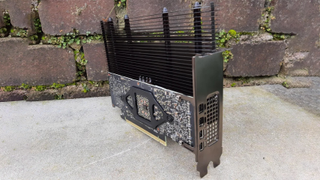Enthusiast Builds Fanless RTX A2000 Graphics Card
An enthusiast shows how to build your own passively cooled graphics card.

Fanless graphics cards are not commonly seen these days as most GPUs tend to get quite hot and require active coolers with two or three fans. Even relatively energy-efficient mainstream. However, an enthusiast took matters into their own hands and built a passively cooled graphics board with a contemporary GPU powered by Nvidia’s Ampere architecture, but cooled by a 15-year old Arctic cooler. They shared the experience at SFF.Network.
In a bid to build his passively cooled graphics card, RevocCases took Nvidia's professional-grade RTX A2000 graphics card based on the GA106 GPU with 3,328 CUDA cores (at up to 1.20 GHz) and a 192-bit memory interface. The card comes with 6GB of memory and is rated for a 70W power consumption, meaning that it does not need an auxiliary PCIe power connector. 70W is of course not much, so the board can indeed be cooled passively with a proper cooler.
That 'proper' cooler is Arctic's Accelero S1 Rev. 2 that was designed for AMD's Radeon HD 3850/3870 and Nvidia's GeForce 8800 GT/8800 GTS from 2008 – 2009. The product can be bought from specialists like CoolerGuys or from Ebay and it is not that expensive. The passive cooler seems to be compatible with Nvidia's RTX A2000 graphics card, though the modder decided to attach a copper plate to the cooler to cool down GDDR6 memory too.


Nvidia's GeForce RTX A2000 graphics card is designed for compact workstations, so this one is not exactly cheap at all. It can be obtained for $356 at Amazon, though it is possible to get it cheaper at Ebay.
It should be noted that Nvidia's RTX A2000 board offers performance akin to that of the GeForce RTX 3060, which is not exactly what demanding gamers might want. Meanwhile, Nvidia recently launched its RTX 4000 SFF Ada Generation board which offers GeForce RTX 3070 (one of the best graphics cards) level performance and carries 24GB of memory. the RTX 4000 SFF consumes only 70W of power and can also be cooled passively, but it has an MSRP of $1,250, which is not cheap.
Unfortunately, to build a passively-cooled graphics card these days, one will need a professional board or to downclock a consumer one. But while it is technically possible to reduce GPU and memory clocks, compatibility with the Accelero S1 Rev. 2 cooling system is not guaranteed as graphics cards are architected for different coolers. That said, it looks like professional graphics cards for compact workstations may be viable options for building fanless graphics cards.
Stay on the Cutting Edge
Join the experts who read Tom's Hardware for the inside track on enthusiast PC tech news — and have for over 25 years. We'll send breaking news and in-depth reviews of CPUs, GPUs, AI, maker hardware and more straight to your inbox.

Anton Shilov is a Freelance News Writer at Tom’s Hardware US. Over the past couple of decades, he has covered everything from CPUs and GPUs to supercomputers and from modern process technologies and latest fab tools to high-tech industry trends.
-
Firestone Thanks for the article, one note, the RTX 4000 ( https://www.tomshardware.com/news/nvidia-tiny-rtx-4000-sff-launched ) has 20GB memory; an important distinction since running local language models currently requires a card with roughly 24GB memory (you got my hopes up for a minute there)Reply -
jabliese Reply
In addition to the memory error on the RTX A4000 noted by Firestone, I believe there is a typo in the RTX A2000 performance comparison, which should be compared to the RTX 2060, not the RTX 3060, "It should be noted that Nvidia's RTX A2000 board offers performance akin to that of the GeForce RTX 3060." A 70W TDP 3060 for $356 would be interesting to a wide range of gamers, unfortunately the RTX A2000 is not that card.Firestone said:Thanks for the article, one note, the RTX 4000 ( https://www.tomshardware.com/news/nvidia-tiny-rtx-4000-sff-launched ) has 20GB memory; an important distinction since running local language models currently requires a card with roughly 24GB memory (you got my hopes up for a minute there)
In any case, I think it is time Tom's included the A2000 and A4000 in the GPU lists. Aside from their TDP, they have some unique properties that make them worth consideration on their own, not just as comparisons to gamer cards. Possibly do not include every memory variant of the cards, but the most interesting ones. -
Firestone to make things even more confusing, the old Ampere model was labeled "RTX A4000", but the new Ada Lovelace model is labeled "RTX 4000 Ada", I believe. Its annoying and pedantic but an important distinction for anyone Google'ing for information 🤦♂️Reply
really appreciate getting coverage of these GPU's though! I am not interested in gaming as much as home server and prospective home AI / ML usages
Most Popular

